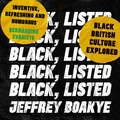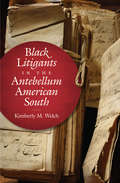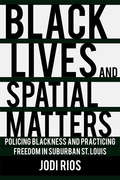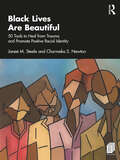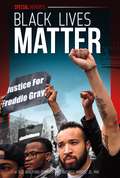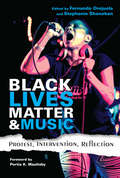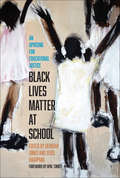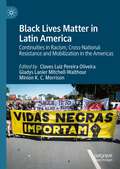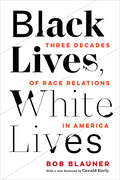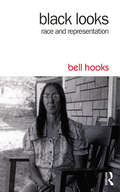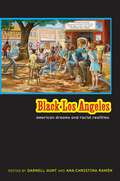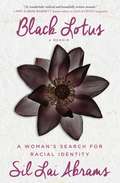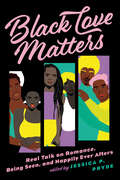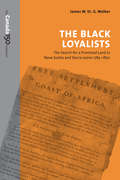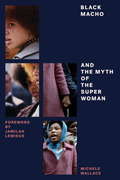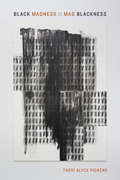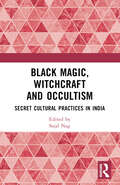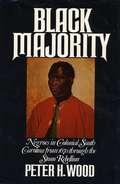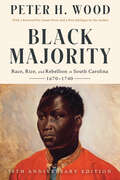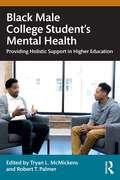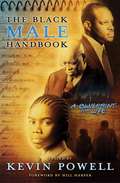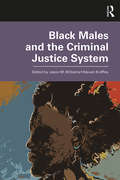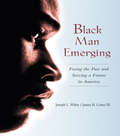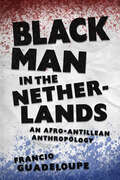- Table View
- List View
Black, Listed: Black British Culture Explored
by Jeffrey BoakyeGUARDIAN MUST READ BOOKS OF 2019 FINANCIAL TIMES BOOKS TO READ 2019 NEW STATESMAN MUST READS 2019'A truly radical book, which manages to be unflinching and constantly entertaining' CAROLINE SANDERSON, THE BOOKSELLER BOOK OF THE MONTH APRIL 2019'This book gives a voice to those whose experience is persistently defined, refined and denied by others' DAVID LAMMY, GUARDIAN *Who is a roadman really? What's wrong with calling someone a 'lighty'? Why do people think black guys are cool?These are just some of the questions being wrestled with in Black, Listed, an exploration of 21st century black identity told through a list of insults, insights and everything in-between.Taking a panoramic look at global black history, interrogating both contemporary and historical culture, Black, Listed investigates the ways in which black communities (and individuals) have been represented, oppressed, mimicked, celebrated, and othered. Part historical study, part autobiographical musing, part pop culture vivisection, it's a comprehensive attempt to make sense of blackness from the vantage point of the hilarious and insightful psyche of Jeffrey Boakye. Along the way, it explores a far reaching range of social and cultural contexts, including but not limited to, sport, art, entertainment, politics, literature, history, music, theatre, cinema, education and criminal justice, sometimes at the same time.
Black Litigants in the Antebellum American South (The John Hope Franklin Series in African American History and Culture)
by Kimberly M. WelchIn the antebellum Natchez district, in the heart of slave country, black people sued white people in all-white courtrooms. They sued to enforce the terms of their contracts, recover unpaid debts, recuperate back wages, and claim damages for assault. They sued in conflicts over property and personal status. And they often won. Based on new research conducted in courthouse basements and storage sheds in rural Mississippi and Louisiana, Kimberly Welch draws on over 1,000 examples of free and enslaved black litigants who used the courts to protect their interests and reconfigure their place in a tense society.To understand their success, Welch argues that we must understand the language that they used--the language of property, in particular--to make their claims recognizable and persuasive to others and to link their status as owner to the ideal of a free, autonomous citizen. In telling their stories, Welch reveals a previously unknown world of black legal activity, one that is consequential for understanding the long history of race, rights, and civic inclusion in America.
Black Lives and Sacred Humanity: Toward an African American Religious Naturalism
by Carol Wayne WhiteIdentifying African American religiosity as the ingenuity of a people constantly striving to inhabit their humanity and eke out a meaningful existence for themselves amid harrowing circumstances, Black Lives and Sacred Humanity constructs a concept of sacred humanity and grounds it in the writings of Anna Julia Cooper, W. E. B. Du Bois, and James Baldwin. Supported by current theories in science studies, critical theory, and religious naturalism, this concept, as Carol Wayne White demonstrates, offers a capacious view of humans as interconnected, social, value-laden organisms with the capacity to transform themselves and create nobler worlds wherein all sentient creatures flourish.Acknowledging the great harm wrought by divisive and problematic racial constructions in the United States, this book offers an alternative to theistic models of African American religiosity to inspire newer, conceptually compelling views of spirituality that address a classic, perennial religious question: What does it mean to be fully human and fully alive?
Black Lives and Spatial Matters: Policing Blackness and Practicing Freedom in Suburban St. Louis (Police/Worlds: Studies in Security, Crime, and Governance)
by Jodi RiosBlack Lives and Spatial Matters is a call to reconsider the epistemic violence that is committed when scholars, policymakers, and the general public continue to frame Black precarity as just another racial, cultural, or ethnic conflict that can be solved solely through legal, political, or economic means. Jodi Rios argues that the historical and material production of blackness-as-risk is foundational to the historical and material construction of our society and certainly foundational to the construction and experience of metropolitan space. She also considers how an ethics of lived blackness—living fully and visibly in the face of forces intended to dehumanize and erase—can create a powerful counter point to blackness-as-risk.Using a transdisciplinary methodology, Black Lives and Spatial Matters studies cultural, institutional, and spatial politics of race in North St. Louis County, Missouri, as a set of practices that are intimately connected to each other and to global histories of race and race-making. As such, the book adds important insight into the racialization of metropolitan space and people in the United States. The arguments presented in this book draw from fifteen years of engaged research in North St. Louis County and rely on multiple disciplinary perspectives and local knowledge in order to study relationships between interconnected practices and phenomena.
Black Lives Are Beautiful: 50 Tools to Heal from Trauma and Promote Positive Racial Identity
by Janeé M. Steele Charmeka S. NewtonBlack Lives Are Beautiful is a workbook explicitly designed to help members of the Black community counter the impacts of racialized trauma while also cultivating self-esteem, building resilience, fostering community, and promoting Black empowerment. As readers explore each part of this workbook, they will develop tools to overcome the mental injuries that occur from living in a racialized society. Clinicians who use this workbook with clients will find a practical toolbox of racially informed interventions to aid clinicians, particularly White clinicians, in culturally sensitive clinical practice.
Black Lives Matter
by Sue Bradford Edwards Duchess HarrisBlack Lives Matter covers the shootings that touched off passionate protests, the work of activists to bring about a more just legal system, and the tensions in US society that these events have brought to light. Aligned to Common Core Standards and correlated to state standards. Essential Library is an imprint of Abdo Publishing, a division of ABDO.
Black Lives Matter and Music: Protest, Intervention, Reflection (Activist Encounters in Folklore and Ethnomusicology)
by Portia K. Maultsby Fernando Orejuela Stephanie ShonekanMusic has always been integral to the Black Lives Matter movement in the United States, with songs such as Kendrick Lamar’s "Alright," J. Cole’s "Be Free," D’Angelo and the Vanguard's "The Charade," The Game’s "Don’t Shoot," Janelle Monae’s "Hell You Talmbout," Usher’s "Chains," and many others serving as unofficial anthems and soundtracks for members and allies of the movement. In this collection of critical studies, contributors draw from ethnographic research and personal encounters to illustrate how scholarly research of, approaches to, and teaching about the role of music in the Black Lives Matter movement can contribute to public awareness of the social, economic, political, scientific, and other forms of injustices in our society. Each chapter in Black Lives Matter and Music focuses on a particular case study, with the goal to inspire and facilitate productive dialogues among scholars, students, and the communities we study. From nuanced snapshots of how African American musical genres have flourished in different cities and the role of these genres in local activism, to explorations of musical pedagogy on the American college campus, readers will be challenged to think of how activism and social justice work might appear in American higher education and in academic research. Black Lives Matter and Music provokes us to examine how we teach, how we conduct research, and ultimately, how we should think about the ways that black struggle, liberation, and identity have evolved in the United States and around the world.
Black Lives Matter at School: An Uprising for Educational Justice
by Denisha Jones, Jesse HagopianThis inspiring collection of accounts from educators and students is “an essential resource for all those seeking to build an antiracist school system” (Ibram X. Kendi).Since 2016, the Black Lives Matter at School movement has carved a new path for racial justice in education. A growing coalition of educators, students, parents and others have established an annual week of action during the first week of February. This anthology shares vital lessons that have been learned through this important work.In this volume, Bettina Love makes a powerful case for abolitionist teaching, Brian Jones looks at the historical context of the ongoing struggle for racial justice in education, and prominent teacher union leaders discuss the importance of anti-racism in their unions. Black Lives Matter at School includes essays, interviews, poems, resolutions, and more from participants across the country who have been building the movement on the ground.
Black Lives Matter in Latin America: Continuities in Racism, Cross-National Resistance and Mobilization in the Americas
by Cloves Luiz Pereira Oliveira Gladys Lanier Mitchell-Walthour Minion K. C. MorrisonThis volume considers how Black activism in Latin America has taken place in varying arenas such as in the academy, digital platforms, and traditional forms of activism. Contributors also examine the impact of activism on policy advocacy and legislation, as well as groups who the Black Lives Matter movement focus on such as women and immigrants. The first part of the book focuses on making Black Lives Matter in academic studies, governmental data, and politics. The next section focuses on the impact of Black activism on policy and legislation in Brazil, Colombia, and Peru. Black activists have been fighting for Black lives throughout Latin America and their struggles have not been in vain, although less policy change has occurred in Peru. The last section finds that social media has allowed for more independent forms of Black activism in Brazil and Cuba.
Black Lives, White Lives: Three Decades of Race Relations in America
by Bob BlaunerNow with a new foreword, this timely reissue features a remarkable collection of oral histories that trace three decades of turbulent race relations and social change in the United States for a new generation of activists. One evening in 1955, Howard Spence, a Mississippi field representative for the NAACP investigating the Emmett Till murder, was confronted by Klansmen who burned an eight-foot cross on his front lawn. "I felt my life wasn't worth a penny with a hole in it." Twenty-four years later, Spence had become a respected pillar of that same Mississippi town, serving as its first Black alderman. The story of Howard Spence is just one of the remarkable personal dramas recounted in Black Lives, White Lives. Beginning in 1968, Bob Blauner and a team of interviewers recorded the words of those caught up in the crucible of rapid racial, social, and political change. Unlike most retrospective oral histories, these interviews capture the intense racial tension of 1968 in real time, as people talk with unusual candor about their deepest fears and prejudices. The diverse experiences and changing beliefs of Blauner's interview subjects—sixteen of them Black, twelve of them white—are expanded through subsequent interviews in 1979 and 1986, revealing as much about ordinary, daily lives as the extraordinary cultural shifts that shaped them. This book remains a landmark historical and sociological document, and an exceptional primary-source commentary on the development of race relations since the 1960s. Republished with a foreword by Professor Gerald Early, Black Lives, White Lives offers new generations of scholars and activists a galvanizing meditation on how divided America was then and still is today.
Black Looks: Race and Representation
by Bell HooksIn the critical essays collected in Black Looks, bell hooks interrogates old narratives and argues for alternative ways to look at blackness, black subjectivity, and whiteness. Her focus is on spectatorship—in particular, the way blackness and black people are experienced in literature, music, television, and especially film—and her aim is to create a radical intervention into the way we talk about race and representation. As she describes: "the essays in Black Looks are meant to challenge and unsettle, to disrupt and subvert." As students, scholars, activists, intellectuals, and any other readers who have engaged with the book since its original release in 1992 can attest, that's exactly what these pieces do.
Black Los Angeles: American Dreams and Racial Realities
by Darnell Hunt Ana-Christina RamonAn in-depth analysis of the historical and contemporary contours of Black life in Los Angeles.Black Los Angeles is the culmination of a groundbreaking research project from the Ralph J. Bunche Center for African American Studies at UCLA that presents an in-depth analysis of the historical and contemporary contours of Black life in Los Angeles. Based on innovative research, the original essays collected here are multi-disciplinary in approach and comprehensive in scope, connecting the dots between the city&’s racial past, present, and future. Through historical and contemporary anecdotes, oral histories, maps, photographs, illustrations, and demographic data, we see that Black L.A. is and has always been a space of profound contradictions. Just as Los Angeles has come to symbolize the complexities of the early 21st century city, so too has Black Los Angeles come to embody the complex realities of race in so-called &“colorblind&” times.Contributors: Melina Abdullah, Alex Alonso, Dionne Bennett, Joshua Bloom, Edna Bonacich, Scot Brown, Reginald Chapple, Lola Smallwood Cuevas, Andrew Deener, Regina Freer, Jooyoung Lee, Mignon R. Moore, Lanita Morris, Neva Pemberton, Steven C. Pitts, Carrie Petrucci, Gwendelyn Rivera, Paul Robinson, M. Belinda Tucker, Paul Von Blum, Mary Weaver, Sonya Winton, and Nancy Wang Yuen.
Black Lotus: A Woman's Search for Racial Identity
by Sil Lai AbramsA unique and exquisitely wrought story of one multiracial woman's journey to discover and embrace herself in a family that sought to deny her black heritage, Sil Lai Abrams shares her story in Black Lotus: A Woman's Search for Racial Identity--an account that will undoubtedly ignite conversation on race, racial identity, and the human experience.Author and activist Sil Lai Abrams was born to a Chinese immigrant mother and a white American father. Out of her family, Sil Lai was the only one with a tousle of wild curls and brown skin. When she asked about her darker complexion, she was given vague answers. At fourteen, the man she knew her entire life as her birth-father divulged that Abrams was not his biological child, but instead the daughter of a man of African descent who didn't know she existed. This shocking news sparked a quest for healing that would take her down the painful road to reclaim her identity despite the overt racism in her community and her own internalized racism and self-hatred. Abrams struggled with depression, abuse, and an addiction that nearly destroyed her. But eventually she would leave behind the shame over her birthright and move toward a celebration of her blackness. In Black Lotus, Abrams takes you on her odyssey filled with extreme highs and lows and the complexities of not only the black experience, but also the human one. This vivid story reexamines everything you think you know about racial identity while affirming the ability of the human spirit to triumph over tragedy. Ultimately, Black Lotus shines a light on the transformative power of truth and self-acceptance, and the importance of defining your personal identity on your own terms.
Black Love Matters: Real Talk on Romance, Being Seen, and Happily Ever Afters
by Jessica P. PrydeAn incisive, intersectional essay anthology that celebrates and examines romance and romantic media through the lens of Black readers, writers, and cultural commentators, edited by Book Riot columnist and librarian Jessica Pryde. Romantic love has been one of the most essential elements of storytelling for centuries. But for Black people in the United States and across the diaspora, it hasn't often been easy to find Black romance joyfully showcased in entertainment media. In this collection, revered authors and sparkling newcomers, librarians and academicians, and avid readers and reviewers consider the mirrors and windows into Black love as it is depicted in the novels, television shows, and films that have shaped their own stories. Whether personal reflection or cultural commentary, these essays delve into Black love now and in the past, including topics from the history of Black romance to social justice and the Black community to the meaning of desire and desirability. Exploring the multifaceted ways love is seen—and the ways it isn't—this diverse array of Black voices collectively shines a light on the power of crafting happy endings for Black lovers. Jessica Pryde is joined by Carole V. Bell, Sarah Hannah Gomez, Jasmine Guillory, Da&’Shaun Harrison, Margo Hendricks, Adriana Herrera, Piper Huguley, Kosoko Jackson, Nicole M. Jackson, Beverly Jenkins, Christina C. Jones, Julie Moody-Freeman, and Allie Parker in this collection.
The Black Loyalists: The Search for a Promised Land in Nova Scotia and Sierra Leone, 1783-1870
by James W. WalkerThere is a Canadian myth about the Loyalists who left the United States after the American Revolution for Canada. The myth says they were white, upper-class citizens devoted to British ideals, transplanting the best of colonial American society to British North America. In reality, more than 10 per cent of the Loyalists who came to the Maritime provinces were black and had been slaves. The Black Loyalists tells the story of one such group who came to Nova Scotia, but didn't stay. James Walker documents their experience in Canada, following them across the Atlantic as they became part of a unique colonial experiment in Sierra Leone.
Black Macho and the Myth of the Superwoman
by Michele Wallace Jamilah LemieuxOriginally published in 1978, Black Macho and the Myth of the Superwoman caused a storm of controversy. Michele Wallace blasted the masculine biases of the black politics that emerged from the sixties. She described how women remained marginalized by the patriarchal culture of Black Power, demonstrating the ways in which a genuine female subjectivity was blocked by the traditional myths of black womanhood. With a foreword that examines the debate the book has sparked between intellectuals and political leaders, as well as what has--and, crucially, has not--changed over the last four decades, Black Macho and the Myth of the Superwoman continues to be deeply relevant to current feminist debates and black theory today.From the Trade Paperback edition.
Black Madness: : Mad Blackness
by Therí Alyce PickensIn Black Madness :: Mad Blackness Therí Alyce Pickens rethinks the relationship between Blackness and disability, unsettling the common theorization that they are mutually constitutive. Pickens shows how Black speculative and science fiction authors such as Octavia Butler, Nalo Hopkinson, and Tananarive Due craft new worlds that reimagine the intersection of Blackness and madness. These creative writer-theorists formulate new parameters for thinking through Blackness and madness. Pickens considers Butler's Fledgling as an archive of Black madness that demonstrates how race and ability shape subjectivity while constructing the building blocks for antiracist and anti-ableist futures. She examines how Hopkinson's Midnight Robber theorizes mad Blackness and how Due's African Immortals series contests dominant definitions of the human. The theorizations of race and disability that emerge from these works, Pickens demonstrates, challenge the paradigms of subjectivity that white supremacy and ableism enforce, thereby pointing to the potential for new forms of radical politics.
Black Magic, Witchcraft and Occultism: Secret Cultural Practices in India
by Sajal NagBlack magic, occult practices and witchcraft still evoke huge curiosity, interest and amazement in the minds of people. Although witchcraft in Europe has been a widely studied phenomenon, black magic and occult are not yet a popular theme of academic research, even though India is known as a land of magic, tantra and occult. The Indian State of Assam was historically feared as the land of Kamrup-Kamakhya, black magic, witchcraft and occultic practices. It was where different Tantric cults as well as other occult practices thrived. The Khasi Hills are known for the practice of snake vampire worship. The village of Mayong is the village, where magic and occult is still practiced as a living tradition. This book is one of the rarest collections where such practices are researched, recorded and academically analyzed. It is one of those collections where studies of all three practices of Black Magic, Witchcraft and Occult are comibned into one single book.
Black Majority: Negroes In Colonial South Carolina From 1670 Through The Stono Rebellion
by Peter WoodAfrican slaves, if taken together, were the largest single group of non-English-speaking migrants to enter the North American colonies in the pre-Revolutionary era. . . . And yet . . . most Americans would find it hard to conceive that the population of one of the thirteen original colonies was well over half black at the time the nation's independence was declared. In this first book to focus so directly upon the earliest Negro inhabitants of the deep South, Peter Wood brilliantly lays to rest the notion that the Afro-American past is unrecoverable and makes it clear that blacks played a significant and often determinative part in early American history. Using a wide variety of source materials, Mr. Wood brings to life the experiences of the black majority in colonial South Carolina. He demonstrates that the role of these early southerners was active, not passive: that their familiarity with rice culture made them an attractive, skilled labor force; that the sickle-cell trait may have been a positive influence in the warding-off of malaria, while a variety of acquired immunities served as protection from other diseases; that their African experiences enabled them to cope, often more effectively than Europeans, with the demands of the New World. He draws attention to Negro involvement in the early frontier, the roots of black English, the scale of black migration, and the plight of slaves who chose to run away. Tracing the worsening of conditions for the black majority as the colony expanded, Mr. Wood shows how tensions between the races grew and how black resistance evolved into calculated acts of rebellion. The most significant of these uprisings occurred near the Stono River in 1739 and rivaled, in its immediate ferocity and long-range implications, the revolt led by Nat Turner in Virginia almost one hundred years later. Until now the story of the Stono Rebellion has never been fully pieced together, and Mr. Wood reveals how the quelling of this uprising represented a turning point for the turbulent first phase of Negro enslavement in the deep South. Beyond its impressive scholarship and the intrinsic interest of its material, Black Majority performs an important service by recovering--and bringing into the American consciousness--a portion of the American past and heritage that has hitherto remained unknown.
Black Majority (50th Anniversary Edition): Race, Rice, And Rebellion In South Carolina, 1670-1740
by Peter H. WoodPeter H. Wood’s groundbreaking history of Blacks in colonial South Carolina, with a new foreword by National Book Award winner Imani Perry. First published in 1974, Black Majority marked a breakthrough in our understanding of early American history. Today, Wood’s insightful study remains more relevant and enlightening than ever. This landmark book chronicles the crucial formative years of North America’s wealthiest and most tormented British colony. It explores how West African familiarity with rice determined the Lowcountry economy and how a skilled but enslaved labor force formed its own distinctive language and culture. While African American history often focuses on the nineteenth and twentieth centuries, Black Majority underscores the significant role early African arrivals played in shaping the direction of American history. This revised and updated fiftieth anniversary edition challenges a fresh generation with provocative history and features a new epilogue by the author.
Black Male College Students' Mental Health: Providing Holistic Support in Higher Education
by Tryan L. McMickens Robert T. PalmerThis important book explores the intersection between mental health and Black college students, providing a crucial resource for higher education administrators and educators. Chapter authors provide invaluable insights into the experiences, joys, challenges, and the needs of Black male college students grappling with their mental health. Chapters cover the most timely topics such as understanding masculinity, providing meaningful career services, supporting Black male student athletes, confronting stigmas, and supporting Black trans men and transmasculine persons.Full of practical examples and strategies, this contributed volume discusses the ways faculty, administrators, and student affairs educators can support and help Black men to navigate problems stemming from mental health issues to help better facilitate and maximize their success in higher education.
The Black Male Handbook: A Blueprint for Life
by Kevin PowellAuthor and activist Kevin Powell and contributors Lasana Omar Hotep, Jeff Johnson, Byron Hurt, Dr. William Jelani Cobb, Ryan Mack, Kendrick B. Nathaniel, and Dr. Andre L. Brown deliver an essential collection of essays for Black men at all stages of their lives on surviving and thriving in an unjust world.The Black Male Handbook answers a collective hunger for new direction, fresh solutions to old problems, and a different kind of conversation—man-to-man and with Black male voices, all from the hip hop generation. The book tackles issues related to political, practical, cultural, and spiritual matters, and ending violence against women and girls. The book also features an appendix filled with useful readings, advice, and resources. The Black Male Handbook is a blueprint for those aspiring to thrive against the odds in America today. This is a must-have book, not only for Black male readers, but the women who befriend, parent, partner, and love them.
Black Males and the Criminal Justice System
by Jason M. Williams Steven KniffleyRelying on a multidisciplinary framework of inquiry and critical perspective, this edited volume addresses the unique experiences of Black males within various stages of contact in the criminal justice system. It provides a comprehensive overview of the administration of justice, mental and physical health issues faced by Black males, and reintegration into society after system involvement. Recent events—including but by no means limited to the shootings of unarmed Black men by police in Ferguson, Missouri; Baltimore; Minneapolis; and Chicago—have highlighted the disproportionate likelihood of young Black males to encounter the criminal justice system. Black Males and the Criminal Justice System provides a theoretical and empirical review of the need for an intersectional understanding of Black male experiences and outcomes within the criminal justice system. The intersectional approach, which posits that outcomes of societal experiences are determined by the way the interconnected identities of individuals are perceived and responded to by others, is key to recognizing the various forms of oppression that Black males experience, and the impact these experiences have on them and their families. This book is intended for students and scholars in criminology, criminal justice, sociology, race/ethnic studies, legal studies, psychology, and African American Studies, and will serve as a reference for researchers who wish to utilize a progressive theoretical approach to study social control, policing, and the criminal justice system.
Black Man Emerging: Facing the Past and Seizing a Future in America
by Joseph L. White James H. Cones IIIFirst published in 2000. Routledge is an imprint of Taylor & Francis, an informa company.
Black Man in the Netherlands: An Afro-Antillean Anthropology
by Francio GuadeloupeFrancio Guadeloupe has lived in both the Dutch Antilles and the Netherlands. An anthropologist by vocation, he is a keen observer by honed habit. In his new book, he wields both personal and anthropological observations. Simultaneously memoir and astute exploration, Black Man in the Netherlands charts Guadeloupe’s coming of age and adulthood in a Dutch world and movingly makes a global contribution to the understanding of anti-Black racism. Guadeloupe identifies the intersections among urban popular culture, racism, and multiculturalism in youth culture in the Netherlands and the wider Dutch Kingdom. He probes the degrees to which traditional ethnic division collapses before a rising Dutch polyethnicity. What comes to light, given the ethnic multiplicity that Afro-Antilleans live, is their extraordinarily successful work in forging an anti-racist Dutch identity via urban popular culture. This alternative way of being Dutch welcomes the Black experience as global and increasingly local Black artists find fame and even idolization. Black Man in the Netherlands is a vivid extension of renowned critical race studies by such Marxist theorists as Achille Mbembe, Paul Gilroy, Stuart Hall, and C. L. R. James, and it bears a palpable connection to such Black Atlantic artists as Peter Tosh, Juan Luis Guerra, and KRS-One. Guadeloupe explores the complexities of Black life in the Netherlands and shows that within their means, Afro-Antilleans often effectively contest Dutch racism in civic and work life.
